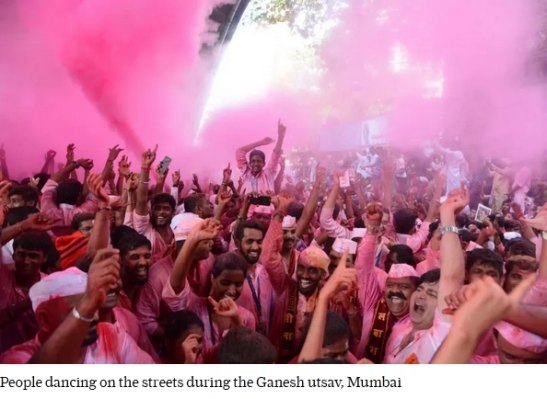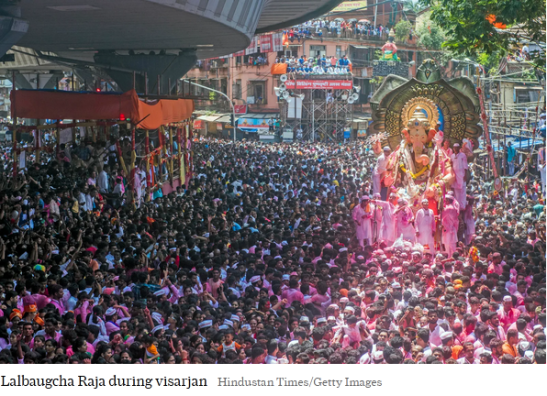Struggle for Hindu Existence
*Hindu Rights to Survive with Dignity & Sovereignty *Join Hindu Freedom Movement to make Bharat Hindu Rashtra within 2025 *Jai Shri Ram *Jayatu Jayatu Hindu Rashtram *Editor: Upananda Brahmachari.
The unique celebration of Mumbai and Pune’s Ganpati visarjan.
Ganpati visarjan: what makes Mumbai and Pune’s celebrations so unique?
The dhol-tasha pathaks, the iconic idols and the influence of the sea…..
~ Maahi Shah.
Ganesh Chaturthi, also known as Vinayaka Chaturthi, marks the birth of the beloved elephant-headed god, Ganesha. The 11-day festival that follows, called Ganesh Utsav, involves the setting up of Ganesh idols at homes and the visarjan, or immersion of these idols on specified days.

While it is celebrated across many parts of India, there is a particularly pervasive pomp and fervour to Ganpati festivities, especially visarjan, in Maharashtra, with elaborate and often pop-culture-themed idols, lavish aartis and prayers, vibrant decor and huge processions. We take a look at what makes visarjan so unique in two of the state’s biggest cities, Mumbai and Pune.
What’s the Sarvajanik Ganesh Utsav?

During the Peshwa era in Maharashtra, every village celebrated the arrival of Ganpati Bappa. But in 1892, revolutionaries like Shrimant Bhausaheb Rangari and Vishwa Bhasavdekar introduced the Sarvajanik Ganesh Utsav in Pune, during which Ganpati pandals were set up across the city for everyone to come and see, and to participate in its rituals. “The people celebrated the utsav through public contribution,” says Pune based historian Mandar Lawate. The festival was also used as a medium to spread the message of Indian independence and promote the Nationalist movement in India. Awareness about the festival was spread across the country from Karachi to the far east in Bangladesh through Bal Gangadhar Tilak’s newspaper, Kesari.

In Mumbai and Pune, Ganesh Utsav is one of the biggest and most awaited festivals of the year. Preparations begin months in advance and by the time Chaturthi comes around, there’s an idol, and music and dance, at every street corner. And this fervour reaches its peak on visarjan days.
The rationale of visarjan
“A long-held belief in Hindu philosophy is that the one thing in life that is permanent is actually impermanence. So whatever little we have should be savoured,” says Professor Radha Kumar of the department of Ancient Indian history, culture and archeology at St. Xavier’s College, Mumbai. This philosophy is also deeply associated with the ideas of Rit (the cosmic-moral order of life) and Rin (the indebtedness of humans). “What it means is, ‘I’m taking something from the earth and I’m giving it back, I’m replenishing it,” she says. These ideas are echoed in the Ganesh Puran, which speaks of going to a river, creating an idol out of clay and bringing it back to the river after 1.5, 5, 7 or 11 days. “So Ganpati comes into your home as a guest and you take care of it and choose to love something so much, and then you must let go,” says Dr Kumar. The act of visarjan is, therefore, an age-old tradition.

But it’s not just that. “It’s an emotional bond because he’s like a very special friend or guest whom you love very much and he’s going away. That’s why we say, ‘Pudhchya varshi lavkarya (Return soon next year),’” says journalist Jayshree Menon.
Dhol-Tasha is no tamasha
The pulsating, frenetic music and dance courtesy DJs and dhol-Tasha pathaks are the same across Mumbai and Pune. “These instruments have no substitute, says 24-year-old Shivani Patil, a dhol player for the Swargandhar Dhol Tasha Pathak in Mumbai. And these are not new-fangled, trendy things; in Maharashtra, in fact, dhol-Tasha pathaks have a long history. “Dhol-Tasha is referred to as ‘ran-vadya’ in Marathi, which means instruments used to encourage warriors before they entered the battlefield,” explains Atharva Deshmukh of the Gandhaar Vadya Pathak in Pune.

On the day of the visarjan, the women wear colourful nauvari saris, a nath and jhumkas, and the men and children wear bright red or saffron-coloured kurtas. The performance (vadan) combines five instruments: dhol, tasha, tol, jhanj and dhvaj, and the patterns are played according to the Puneri folk tradition. “We don’t try too many modern beats because that’s not what we want to do; we want to bring out our traditions,” says Urja Shah, also part of the Swargandhar Pathak. Women and children are always in the centre of the formation and the group of 100 plays for hours together. And when the rain falls, it gets even better. “A lot of people don’t like rain during the time of visarjan,” Shah tells CNT, “But we love it. If it rains during a vadan, it’s a different high. In 2019, it rained so heavily and the sounds of the instruments reverberated in a way you can’t even imagine.”

These traditional pathaks have become a major part of public visarjan processions. And they remain unaffected by the rise of DJs, rave parties and loudspeakers. “I think people prefer dhol-Tasha to anything else during visarjan, and whoever enjoys it will continue to listen to it. We live the tradition. The amount of energy we put into it gets reflected in the audience and their reaction. If we aren’t enjoying ourselves, people won’t either,” says Shah.
The sea makes a big difference
One major difference in how the two cities celebrate this festival is the sea. Mumbai is nestled along the Arabian Sea where most public celebrations end up to immerse the idols. In Pune, an artificial tank near the Mula-Mutha river in Pune is where most of the idols have been immersed since 2015. This difference also impacts the size of the idols that are created in the two cities. While Pune sees idols about 3 to 4 feet tall, in Mumbai, they are larger than life, some going up to 12 ft in height. Also, given Mumbai’s association with Bollywood, idols are often crafted to resemble famous movie actors or characters.

Of course, it’s impossible to speak of the visarjan culture in Mumbai without mentioning the city’s most prominent idol, Lalbaugcha Raja, who sits on his throne at the pandal in Lalbaug while lakhs of devotees, including major Bollywood actors, from Amitabh Bachchan to Kangana Ranaut, come for darshan.

More than 10 lakh people gather on the streets of Mumbai to witness the visarjan procession. “Since its inception in 1934, we have only received support from the people, be it any community or religion,” says Shri Balasaheb Sudam Kamble, president of the Lalbaugcha Raja Ganesh Utsav Mandal. The mandal’s thousands of volunteers take to the road at 10am on Anant Chaturdashi, the 10th day of the festival. And the route hasn’t changed in 89 years. Beginning at Lalbaug market, they move slowly through Dr Ambedkar Marg, Bharat Mata Theatre, Lalbaug market, Chinchpokli bridge, Arthur Road naka, NM Joshi Marg – and as they cross the Byculla fire station, the sirens of the fire brigades are heard to pay respects to the wish-granting Ganpati. From there they move towards Duncan Road, Kumbharwada and VP Road Police station before reaching Girgaon Chowpatty.
…
Courtesy: Maahi Shah in Condé Nast Traveller.
This article was first published in CNTraveller on Sept 6, 2022.


[…] 1 000 filles hindoues sont converties de force chaque année… […]
What's the reaction of the CM of Telangana? ________________________________
Each visitor(devotee) entering the temple must be thoroughly checked and let in to the temple.
Respected Dr Naidoo, Namaste. Once you subscribed our website, you are getting auto generated email to the subsribers. We feel…
Please remove my name from your mailing list. My age no longer allows proper communication.